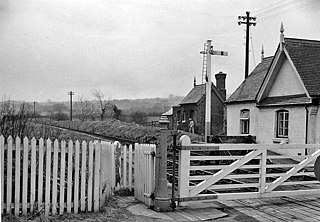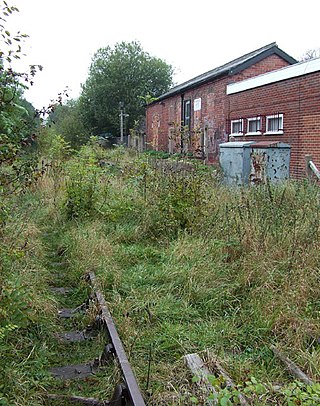
Biddulph is a town in Staffordshire, England, 8.5 miles (14 km) north of Stoke-on-Trent and 4.5 miles (7 km) south-east of Congleton, Cheshire.

The North Staffordshire Railway (NSR) was a British railway company formed in 1845 to promote a number of lines in the Staffordshire Potteries and surrounding areas in Staffordshire, Cheshire, Derbyshire and Shropshire.

Caldon Canal is a branch of the Trent and Mersey Canal which opened in 1779. It runs 18 miles (29 km) from Etruria, Stoke-on-Trent, to Froghall, Staffordshire. The canal has 17 locks and the 76-yard (69 m) Froghall Tunnel.

Congleton railway station is a mainline station serving the Cheshire town of Congleton. It lies on the Stafford-Manchester branch of the West Coast Main Line in the United Kingdom.
Smallthorne is an area in the city of Stoke-on-Trent in Staffordshire, England. It is in the north-east of the city, near Burslem. Smallthorne borders Bradeley and Chell in the north, Norton-in-the-Moors in the east, Sneyd Green in the south, and Burslem in the west.
Sneyd Green is an area in the city of Stoke-on-Trent, Staffordshire, England, in the north-east of the city, 1.5 miles (2.4 km) from Hanley. Sneyd Green borders Smallthorne in the north, Milton in the east, Birches Head in the south, and Cobridge in the west.
Smallthorne Urban District was an urban district in Staffordshire, England. It was initially formed of the Smallthorne civil parish. In 1904 the Chell and Milton civil parishes were added. It was abolished in 1922 with the bulk of it becoming part of the county borough of Stoke-on-Trent.
The Churnet Valley line was one of the three original routes planned and built by the North Staffordshire Railway. Authorised in 1846, the line opened in 1849 and ran from North Rode in Cheshire to Uttoxeter in East Staffordshire. The line was closed in several stages between 1964 and 1988 but part of the central section passed into the hands of a preservation society and today operates as the Churnet Valley Railway.

Biddulph railway station was a railway station opened by the North Staffordshire Railway in 1864. Originally named Gillow Heath the station was renamed Biddulph on 1 May 1897. The station was on the Biddulph Valley line that ran from a junction just north of Congleton on the Stoke-on-Trent – Macclesfield line to a junction south of Stoke-on-Trent station.
The Stoke to Leek line is a mothballed railway route, which up until 1988 was used by BR freight trains to reach the quarries at both Cauldon Lowe and Oakamoor.

Chell is a suburb of the city of Stoke-on-Trent in the ceremonial county of Staffordshire, England, that can be subdivided into Little Chell, Great Chell and Chell Heath. It lies on the northern edge of the city, approximately 1-mile (1.6 km) from Tunstall, 2 miles (3.2 km) from Burslem and 3 miles (4.8 km) from the county border with Cheshire. Chell borders Pitts Hill to the west, Tunstall to the south west, Stanfield and Bradeley to the south, with the outlying villages of Packmoor and Brindley Ford to the north and Ball Green to the east. Since 2011 the area has been divided into the electoral wards of Bradeley & Chell Heath, Great Chell & Packmoor and Little Chell & Stanfield.

Bucknall and Northwood railway station was opened by the North Staffordshire Railway in 1864 to serve the Bucknall area of Stoke-on-Trent. Situated on the company's Biddulph Valley line, the station was served by passenger trains between Stoke and Congleton on the Biddulph Valley line and by trains between Stoke and Leek on the Stoke-Leek line. Passenger services on the Biddulph line ceased in 1927, but services on the Leek line continued until May 1956. After this date the station was still used for special and excursion trains until complete closure in 1962.

Endon railway station is a disused railway station in Staffordshire.

Ford Green & Smallthorne railway station is a disused railway station in Stoke-on-Trent, England.

The Stoke-on-Trent Green Belt is a green belt environmental and planning policy that regulates the rural space throughout mainly the West Midlands region of England. It is contained within the counties of Cheshire and Staffordshire. Essentially, the function of the designated area is to prevent surrounding towns and villages within the Stoke-on-Trent conurbation from further convergence. It is managed by local planning authorities on guidance from central government.
Leek railway station is the proposed and future terminus of the Churnet Valley Railway and is currently awaiting construction. It will be the second railway station in Leek.
Brunswick Wharf was a railway goods yard in Buglawton, Congleton.
Mossley Halt was a railway station in Mossley, Congleton on the Biddulph Valley line. Mossley Halt was located about 1 and a half miles south of Congleton Railway Station.










